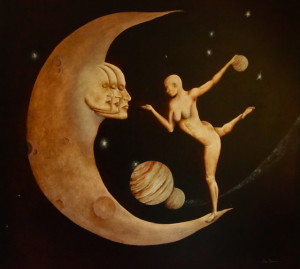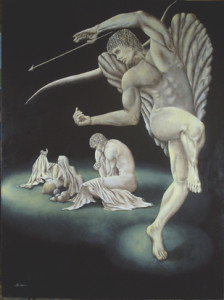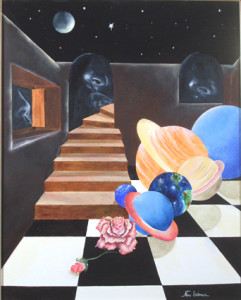Arts Week Blogs
A Penny for Your (Artistic) Thoughts: Nino Scimeca
 One doesn’t normally expect to see fine art gracing the walls of a bed-and-breakfast, but that’s exactly what you’ll find at the Penny House Inn in Eastham: owner Melissa Leonard has filled the open spaces of the inn’s living-room with paintings by her cousin, Italian artist Nino Scimeca, and the effect is extraordinarily powerful.
One doesn’t normally expect to see fine art gracing the walls of a bed-and-breakfast, but that’s exactly what you’ll find at the Penny House Inn in Eastham: owner Melissa Leonard has filled the open spaces of the inn’s living-room with paintings by her cousin, Italian artist Nino Scimeca, and the effect is extraordinarily powerful.
The paintings were on loan this spring and summer to Sal’s Place in Provincetown, another unusual venue for a gallery, but one that, on reflection, feels very appropriate. Italian food and Italian art, after all, seem to be made for one another.
 Scimeca was pleased about showing at Sal’s Place. “People who would not go to see paintings in a gallery, they see the art here,” he said. “It is a new and different audience for my work.”
Scimeca was pleased about showing at Sal’s Place. “People who would not go to see paintings in a gallery, they see the art here,” he said. “It is a new and different audience for my work.”
Nino Scimeca doesn’t exactly lack for an audience; his paintings are in private collections all over the world and he’s displayed in galleries throughout his native Italy and the United States. But reaching out to Provincetown through a combination of food and art appealed to him; Scimeca has always been interested in the reactions of non-art-critics, the responses of “normal people going into my oil painting scene and, like a daydream, living the intense atmosphere created in there.”
Scimeca’s art does create an intense atmosphere—along with an intense conversation. It’s difficult to look at any of his pieces without feeling the pull to engage with it: what is meant here? What is that person thinking, feeling, desiring? Why is there such a resonance here? The art embraces—and challenges—the human condition. Bold and edgy, it’s alive with primary colors and unexpected vistas.
 His own favorite painting is the Renaissance-inspired Cupid on Human Apathy. That choice may not be accidental: Scimeca himself uses a Renaissance technique—employed by da Vinci, Michelangelo, Titian, Velazquez, and Caravaggio—called velatura, used to integrate or modify layers on a painting. A velatura is a thin layer of paint, spread out so it creates a milky or foggy haze that obscures some—but not all—of what’s beneath it. Like a glaze, it uses an opaque or semi-opaque pigment rather than a transparent one. Titian is said to have exclaimed, “Trenta, quaranta velature!” and indeed it seems appropriate to keep adding layers: the images both come alive in unexpected ways and at the same time retain some mystery through the use of the glaze layering.
His own favorite painting is the Renaissance-inspired Cupid on Human Apathy. That choice may not be accidental: Scimeca himself uses a Renaissance technique—employed by da Vinci, Michelangelo, Titian, Velazquez, and Caravaggio—called velatura, used to integrate or modify layers on a painting. A velatura is a thin layer of paint, spread out so it creates a milky or foggy haze that obscures some—but not all—of what’s beneath it. Like a glaze, it uses an opaque or semi-opaque pigment rather than a transparent one. Titian is said to have exclaimed, “Trenta, quaranta velature!” and indeed it seems appropriate to keep adding layers: the images both come alive in unexpected ways and at the same time retain some mystery through the use of the glaze layering.
 The mystery isn’t accidental. Scimeca’s canvases speak of a dreamworld, of communion with the moon, of moving effortlessly through multiple dimensions, of drifting on either side of the earthly plane. “My dream?” asks Scimeca. “It’s leaving a trace, even if no one will remember your name. It doesn’t matter, it will remain your trace anyway, your message on the human highway. And if one day in the dusty loft of some old house, a child looking for some junk to play with finds an old canvas with my name on, and looking at it, feels what I felt… I will have been paid for my efforts.”
The mystery isn’t accidental. Scimeca’s canvases speak of a dreamworld, of communion with the moon, of moving effortlessly through multiple dimensions, of drifting on either side of the earthly plane. “My dream?” asks Scimeca. “It’s leaving a trace, even if no one will remember your name. It doesn’t matter, it will remain your trace anyway, your message on the human highway. And if one day in the dusty loft of some old house, a child looking for some junk to play with finds an old canvas with my name on, and looking at it, feels what I felt… I will have been paid for my efforts.”












